Yi-Fan Zhang
MME-Unify: A Comprehensive Benchmark for Unified Multimodal Understanding and Generation Models
Apr 07, 2025Abstract:Existing MLLM benchmarks face significant challenges in evaluating Unified MLLMs (U-MLLMs) due to: 1) lack of standardized benchmarks for traditional tasks, leading to inconsistent comparisons; 2) absence of benchmarks for mixed-modality generation, which fails to assess multimodal reasoning capabilities. We present a comprehensive evaluation framework designed to systematically assess U-MLLMs. Our benchmark includes: Standardized Traditional Task Evaluation. We sample from 12 datasets, covering 10 tasks with 30 subtasks, ensuring consistent and fair comparisons across studies." 2. Unified Task Assessment. We introduce five novel tasks testing multimodal reasoning, including image editing, commonsense QA with image generation, and geometric reasoning. 3. Comprehensive Model Benchmarking. We evaluate 12 leading U-MLLMs, such as Janus-Pro, EMU3, VILA-U, and Gemini2-flash, alongside specialized understanding (e.g., Claude-3.5-Sonnet) and generation models (e.g., DALL-E-3). Our findings reveal substantial performance gaps in existing U-MLLMs, highlighting the need for more robust models capable of handling mixed-modality tasks effectively. The code and evaluation data can be found in https://mme-unify.github.io/.
Aligning Multimodal LLM with Human Preference: A Survey
Mar 18, 2025Abstract:Large language models (LLMs) can handle a wide variety of general tasks with simple prompts, without the need for task-specific training. Multimodal Large Language Models (MLLMs), built upon LLMs, have demonstrated impressive potential in tackling complex tasks involving visual, auditory, and textual data. However, critical issues related to truthfulness, safety, o1-like reasoning, and alignment with human preference remain insufficiently addressed. This gap has spurred the emergence of various alignment algorithms, each targeting different application scenarios and optimization goals. Recent studies have shown that alignment algorithms are a powerful approach to resolving the aforementioned challenges. In this paper, we aim to provide a comprehensive and systematic review of alignment algorithms for MLLMs. Specifically, we explore four key aspects: (1) the application scenarios covered by alignment algorithms, including general image understanding, multi-image, video, and audio, and extended multimodal applications; (2) the core factors in constructing alignment datasets, including data sources, model responses, and preference annotations; (3) the benchmarks used to evaluate alignment algorithms; and (4) a discussion of potential future directions for the development of alignment algorithms. This work seeks to help researchers organize current advancements in the field and inspire better alignment methods. The project page of this paper is available at https://github.com/BradyFU/Awesome-Multimodal-Large-Language-Models/tree/Alignment.
From Correctness to Comprehension: AI Agents for Personalized Error Diagnosis in Education
Feb 19, 2025Abstract:Large Language Models (LLMs), such as GPT-4, have demonstrated impressive mathematical reasoning capabilities, achieving near-perfect performance on benchmarks like GSM8K. However, their application in personalized education remains limited due to an overemphasis on correctness over error diagnosis and feedback generation. Current models fail to provide meaningful insights into the causes of student mistakes, limiting their utility in educational contexts. To address these challenges, we present three key contributions. First, we introduce \textbf{MathCCS} (Mathematical Classification and Constructive Suggestions), a multi-modal benchmark designed for systematic error analysis and tailored feedback. MathCCS includes real-world problems, expert-annotated error categories, and longitudinal student data. Evaluations of state-of-the-art models, including \textit{Qwen2-VL}, \textit{LLaVA-OV}, \textit{Claude-3.5-Sonnet} and \textit{GPT-4o}, reveal that none achieved classification accuracy above 30\% or generated high-quality suggestions (average scores below 4/10), highlighting a significant gap from human-level performance. Second, we develop a sequential error analysis framework that leverages historical data to track trends and improve diagnostic precision. Finally, we propose a multi-agent collaborative framework that combines a Time Series Agent for historical analysis and an MLLM Agent for real-time refinement, enhancing error classification and feedback generation. Together, these contributions provide a robust platform for advancing personalized education, bridging the gap between current AI capabilities and the demands of real-world teaching.
VITA-1.5: Towards GPT-4o Level Real-Time Vision and Speech Interaction
Jan 03, 2025Abstract:Recent Multimodal Large Language Models (MLLMs) have typically focused on integrating visual and textual modalities, with less emphasis placed on the role of speech in enhancing interaction. However, speech plays a crucial role in multimodal dialogue systems, and implementing high-performance in both vision and speech tasks remains a significant challenge due to the fundamental modality differences. In this paper, we propose a carefully designed multi-stage training methodology that progressively trains LLM to understand both visual and speech information, ultimately enabling fluent vision and speech interaction. Our approach not only preserves strong vision-language capacity, but also enables efficient speech-to-speech dialogue capabilities without separate ASR and TTS modules, significantly accelerating multimodal end-to-end response speed. By comparing our method against state-of-the-art counterparts across benchmarks for image, video, and speech tasks, we demonstrate that our model is equipped with both strong visual and speech capabilities, making near real-time vision and speech interaction.
TimeRAF: Retrieval-Augmented Foundation model for Zero-shot Time Series Forecasting
Dec 30, 2024Abstract:Time series forecasting plays a crucial role in data mining, driving rapid advancements across numerous industries. With the emergence of large models, time series foundation models (TSFMs) have exhibited remarkable generalization capabilities, such as zero-shot learning, through large-scale pre-training. Meanwhile, Retrieval-Augmented Generation (RAG) methods have been widely employed to enhance the performance of foundation models on unseen data, allowing models to access to external knowledge. In this paper, we introduce TimeRAF, a Retrieval-Augmented Forecasting model that enhance zero-shot time series forecasting through retrieval-augmented techniques. We develop customized time series knowledge bases that are tailored to the specific forecasting tasks. TimeRAF employs an end-to-end learnable retriever to extract valuable information from the knowledge base. Additionally, we propose Channel Prompting for knowledge integration, which effectively extracts relevant information from the retrieved knowledge along the channel dimension. Extensive experiments demonstrate the effectiveness of our model, showing significant improvement across various domains and datasets.
MME-Survey: A Comprehensive Survey on Evaluation of Multimodal LLMs
Nov 22, 2024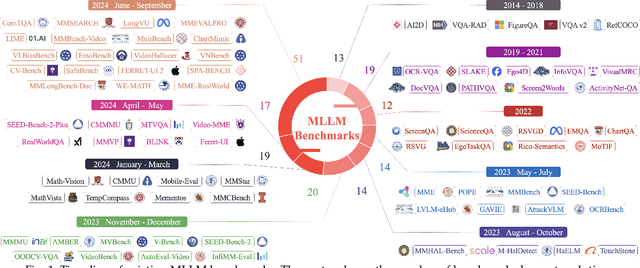
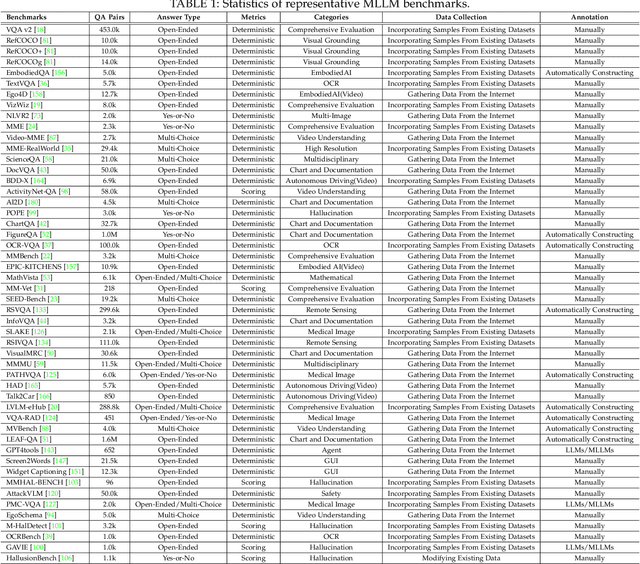
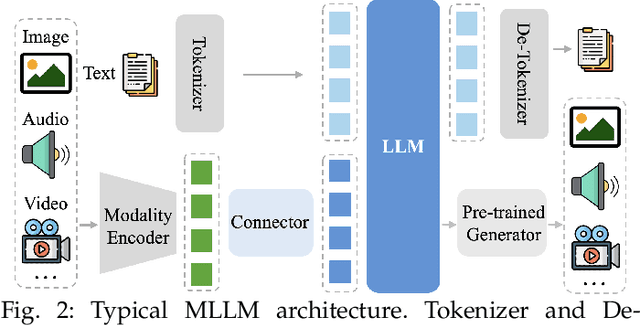
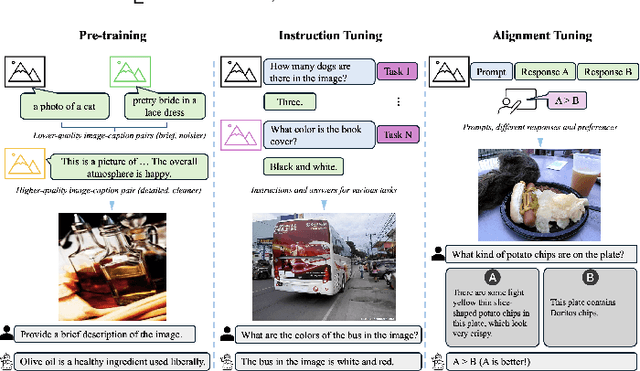
Abstract:As a prominent direction of Artificial General Intelligence (AGI), Multimodal Large Language Models (MLLMs) have garnered increased attention from both industry and academia. Building upon pre-trained LLMs, this family of models further develops multimodal perception and reasoning capabilities that are impressive, such as writing code given a flow chart or creating stories based on an image. In the development process, evaluation is critical since it provides intuitive feedback and guidance on improving models. Distinct from the traditional train-eval-test paradigm that only favors a single task like image classification, the versatility of MLLMs has spurred the rise of various new benchmarks and evaluation methods. In this paper, we aim to present a comprehensive survey of MLLM evaluation, discussing four key aspects: 1) the summarised benchmarks types divided by the evaluation capabilities, including foundation capabilities, model self-analysis, and extented applications; 2) the typical process of benchmark counstruction, consisting of data collection, annotation, and precautions; 3) the systematic evaluation manner composed of judge, metric, and toolkit; 4) the outlook for the next benchmark. This work aims to offer researchers an easy grasp of how to effectively evaluate MLLMs according to different needs and to inspire better evaluation methods, thereby driving the progress of MLLM research.
ErrorRadar: Benchmarking Complex Mathematical Reasoning of Multimodal Large Language Models Via Error Detection
Oct 06, 2024


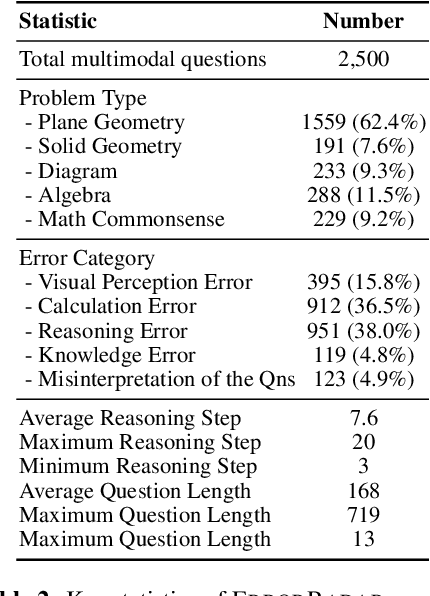
Abstract:As the field of Multimodal Large Language Models (MLLMs) continues to evolve, their potential to revolutionize artificial intelligence is particularly promising, especially in addressing mathematical reasoning tasks. Current mathematical benchmarks predominantly focus on evaluating MLLMs' problem-solving ability, yet there is a crucial gap in addressing more complex scenarios such as error detection, for enhancing reasoning capability in complicated settings. To fill this gap, we formally formulate the new task: multimodal error detection, and introduce ErrorRadar, the first benchmark designed to assess MLLMs' capabilities in such a task. ErrorRadar evaluates two sub-tasks: error step identification and error categorization, providing a comprehensive framework for evaluating MLLMs' complex mathematical reasoning ability. It consists of 2,500 high-quality multimodal K-12 mathematical problems, collected from real-world student interactions in an educational organization, with rigorous annotation and rich metadata such as problem type and error category. Through extensive experiments, we evaluated both open-source and closed-source representative MLLMs, benchmarking their performance against educational expert evaluators. Results indicate significant challenges still remain, as GPT-4o with best performance is still around 10% behind human evaluation. The dataset will be available upon acceptance.
AI-Driven Virtual Teacher for Enhanced Educational Efficiency: Leveraging Large Pretrain Models for Autonomous Error Analysis and Correction
Sep 14, 2024



Abstract:Students frequently make mistakes while solving mathematical problems, and traditional error correction methods are both time-consuming and labor-intensive. This paper introduces an innovative \textbf{V}irtual \textbf{A}I \textbf{T}eacher system designed to autonomously analyze and correct student \textbf{E}rrors (VATE). Leveraging advanced large language models (LLMs), the system uses student drafts as a primary source for error analysis, which enhances understanding of the student's learning process. It incorporates sophisticated prompt engineering and maintains an error pool to reduce computational overhead. The AI-driven system also features a real-time dialogue component for efficient student interaction. Our approach demonstrates significant advantages over traditional and machine learning-based error correction methods, including reduced educational costs, high scalability, and superior generalizability. The system has been deployed on the Squirrel AI learning platform for elementary mathematics education, where it achieves 78.3\% accuracy in error analysis and shows a marked improvement in student learning efficiency. Satisfaction surveys indicate a strong positive reception, highlighting the system's potential to transform educational practices.
MME-RealWorld: Could Your Multimodal LLM Challenge High-Resolution Real-World Scenarios that are Difficult for Humans?
Aug 23, 2024



Abstract:Comprehensive evaluation of Multimodal Large Language Models (MLLMs) has recently garnered widespread attention in the research community. However, we observe that existing benchmarks present several common barriers that make it difficult to measure the significant challenges that models face in the real world, including: 1) small data scale leads to a large performance variance; 2) reliance on model-based annotations results in restricted data quality; 3) insufficient task difficulty, especially caused by the limited image resolution. To tackle these issues, we introduce MME-RealWorld. Specifically, we collect more than $300$K images from public datasets and the Internet, filtering $13,366$ high-quality images for annotation. This involves the efforts of professional $25$ annotators and $7$ experts in MLLMs, contributing to $29,429$ question-answer pairs that cover $43$ subtasks across $5$ real-world scenarios, extremely challenging even for humans. As far as we know, MME-RealWorld is the largest manually annotated benchmark to date, featuring the highest resolution and a targeted focus on real-world applications. We further conduct a thorough evaluation involving $28$ prominent MLLMs, such as GPT-4o, Gemini 1.5 Pro, and Claude 3.5 Sonnet. Our results show that even the most advanced models struggle with our benchmarks, where none of them reach $60\%$ accuracy. The challenges of perceiving high-resolution images and understanding complex real-world scenarios remain urgent issues to be addressed. The data and evaluation code are released at https://mme-realworld.github.io/ .
Beyond LLaVA-HD: Diving into High-Resolution Large Multimodal Models
Jun 12, 2024Abstract:Seeing clearly with high resolution is a foundation of Large Multimodal Models (LMMs), which has been proven to be vital for visual perception and reasoning. Existing works usually employ a straightforward resolution upscaling method, where the image consists of global and local branches, with the latter being the sliced image patches but resized to the same resolution as the former. This means that higher resolution requires more local patches, resulting in exorbitant computational expenses, and meanwhile, the dominance of local image tokens may diminish the global context. In this paper, we dive into the problems and propose a new framework as well as an elaborate optimization strategy. Specifically, we extract contextual information from the global view using a mixture of adapters, based on the observation that different adapters excel at different tasks. With regard to local patches, learnable query embeddings are introduced to reduce image tokens, the most important tokens accounting for the user question will be further selected by a similarity-based selector. Our empirical results demonstrate a `less is more' pattern, where \textit{utilizing fewer but more informative local image tokens leads to improved performance}. Besides, a significant challenge lies in the training strategy, as simultaneous end-to-end training of the global mining block and local compression block does not yield optimal results. We thus advocate for an alternating training way, ensuring balanced learning between global and local aspects. Finally, we also introduce a challenging dataset with high requirements for image detail, enhancing the training of the local compression layer. The proposed method, termed LMM with Sophisticated Tasks, Local image compression, and Mixture of global Experts (SliME), achieves leading performance across various benchmarks with only 2 million training data.
 Add to Chrome
Add to Chrome Add to Firefox
Add to Firefox Add to Edge
Add to Edge